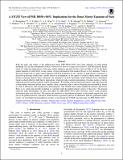A NICER View of PSR J0030+0451: Implications for the Dense Matter Equation of State
Author(s)
Chakrabarty, Deepto
DownloadPublished version (978.5Kb)
Publisher Policy
Publisher Policy
Article is made available in accordance with the publisher's policy and may be subject to US copyright law. Please refer to the publisher's site for terms of use.
Terms of use
Metadata
Show full item recordAbstract
Both the mass and radius of the millisecond pulsar PSR J0030+0451 have been inferred via pulse-profile modeling of X-ray data obtained by NASA's Neutron Star Interior Composition Explorer (NICER) mission. In this Letter we study the implications of the mass-radius inference reported for this source by Riley et al. for the dense matter equation of state (EoS), in the context of prior information from nuclear physics at low densities. Using a Bayesian framework we infer central densities and EoS properties for two choices of high-density extensions: a piecewise-polytropic model and a model based on assumptions of the speed of sound in dense matter. Around nuclear saturation density these extensions are matched to an EoS uncertainty band obtained from calculations based on chiral effective field theory interactions, which provide a realistic description of atomic nuclei as well as empirical nuclear matter properties within uncertainties. We further constrain EoS expectations with input from the current highest measured pulsar mass; together, these constraints offer a narrow Bayesian prior informed by theory as well as laboratory and astrophysical measurements. The NICER mass-radius likelihood function derived by Riley et al. using pulse-profile modeling is consistent with the highest-density region of this prior. The present relatively large uncertainties on mass and radius for PSR J0030+0451 offer, however, only a weak posterior information gain over the prior. We explore the sensitivity to the inferred geometry of the heated regions that give rise to the pulsed emission, and find a small increase in posterior gain for an alternative (but less preferred) model. Lastly, we investigate the hypothetical scenario of increasing the NICER exposure time for PSR J0030+0451.
Date issued
2019-12Department
Massachusetts Institute of Technology. Department of Physics; MIT Kavli Institute for Astrophysics and Space ResearchJournal
Astrophysical Journal Letters
Publisher
American Astronomical Society
Citation
Raaijmakers, G., et al., "A NICER View of PSR J0030+0451: Implications for the Dense Matter Equation of State." Astrophysical Journal Letters 887, 1 (Dec. 2019): letter 22 doi 10.3847/2041-8213/ab451a ©2019 Author(s)
Version: Final published version
ISSN
2041-8213